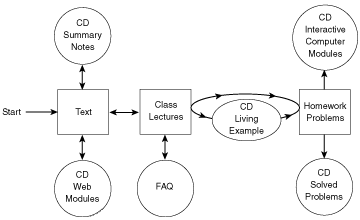
Figure CDI-1 Student Pathway to Integral Class, Text, DVD.
Welcome Usage Navigation
(Click on Desired Link)
Usage
How to Use the DVD
The primary purpose of the DVD is to serve as an enrichment resource. The objectives are fourfold:
(1) To provide the option/opportunity for further study or clarification on a particular concept or topic through Lecture Notes, additional examples, interactive computing modules and web modules
(2) To provide the opportunity to practice critical thinking skills, creative thinking skills, and problem solving skills through the use of "What if..." questions and "living example problems"
(3) To provide additional technical material for the professional bookshelf
(4) To provide other tutorial information, such as additional homework problems, thoughts on problem solving, how to use computational software in chemical reaction engineering, and a representative course structure
There are a number of ways one can use the DVD in conjunction with the text. The general guideline is that the DVD provides enrichment resources for the reader. Pathways on how to use the materials to learn chemical reaction engineering are shown in Figure CDI-1 and CDI-2.
The keys to the CRE learning flow sheet are:
Squares = Primary Resources
Circles/Ovals = Enrichment Resources
I. University Student

II. Practicing Engineer

III. Instructor

The author recommends that instructors use the living example problems before assigning home problems, but they may be by-passed if time is not available. This is, of course, true for all of the enrichment resources. Please note, however, that class testing has shown that the enrichment resources not only aid students in learning the material, but they also motivate students by the novel use of CRE principles.
Possible Implementation Strategies
I. Learning Resources
II. Living Example Problems
- Lecture Notes: This material could be reviewed before reading the chapter get an overview of the material.
- Interactive Computer Games (ICG): Each module requires approximately 30 minutes to complete. If a module is not assigned or required, the student could quickly go through the Review of Fundamentals Section to get an overview or to review (ca. 10 min.). The complete modules could be used by the student as a self test to check their level of understanding. A number of schools assign one either every week or every other week.
- Web Modules: This material can be used to motivate students by showing them the wide range of CRE applications or as a basis for special projects or open-ended problems.
- Solved Examples: After reading the material in the chapters and studying the example problems, students have the opportunity to see one or two more solved problems before embarking on solutions of the homework problems.
These Living Example Problems are one of the things that sets this text apart from other texts. In most all other texts the parameter values cannot be changed and the student only sees one answer. The student is not able to explore how the magnitude of the answer shown would change if say, a different reaction temperature were given. In this text the students can load the Living Example Problems on to their computers and vary the parameter values on order to get a better understanding of principles involved and the sensitivity of the reactions and reactors to these parameters. These examples are meant to be used in conjunction with the first or second problem of every chapter, beginning with Chapter 4 (i.e. P4-2). Typically one might assign a living example problem as one of the first problems assigned in a chapter to get students familiar and comfortable with the material and then assign problems that students must apply the principles to new situations.
III. Professional Reference ShelfThis material is important to the practicing engineer, but is not included in the majority of undergraduate or graduate courses in chemical reaction engineering. Consequently, instructors my pick and choose from this material along the lines of special topics.
IV. Additional Homework ProblemsOne of the things instructors have told me they like in a new edition is new homework problems. However, many instructors have favorite problems that they have used over the years and want to continue to use them. Consequently, a number of the old favorite problems from previous editions are included on the DVD and the solution manual.
V. The Web (http://www.umich.edu/~essen or http://www.essentialsofcre.com/)
The web will be used to update the DVD and text material, provide new examples and more solved problems, and correct any typographical errors from printings of the text.
Welcome Usage Navigation
(Click on Desired Link)
Begin: Chapter 1